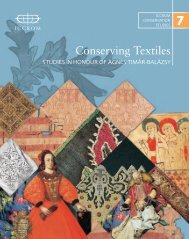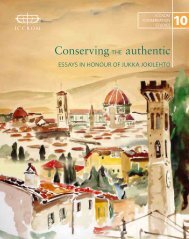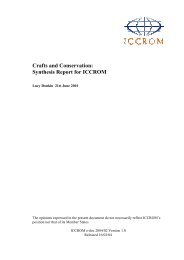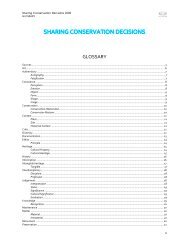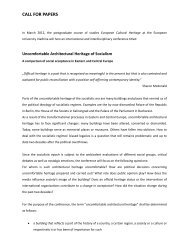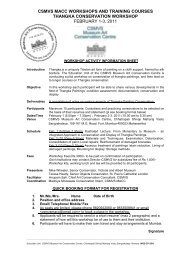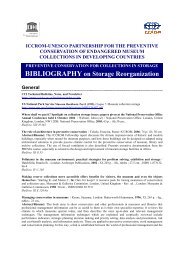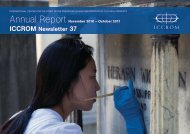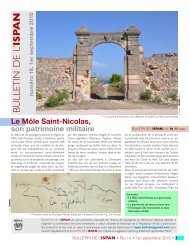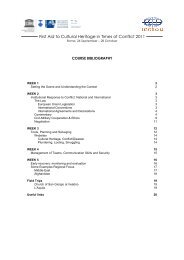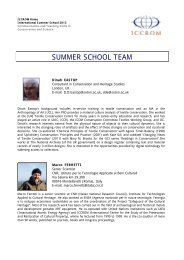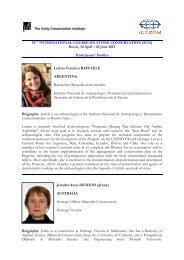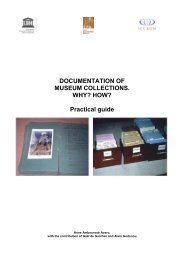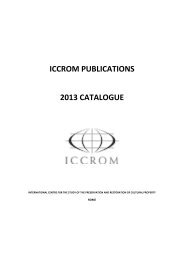part 1 - Iccrom
part 1 - Iccrom
part 1 - Iccrom
You also want an ePaper? Increase the reach of your titles
YUMPU automatically turns print PDFs into web optimized ePapers that Google loves.
¿Conservar uma feira livre? Or, preserving dynamic, complex heritage by<br />
accenting societal character and socio-spatial conceptualization<br />
Klaus Hartwig Brendle 1<br />
Abstract<br />
Contributing to the challenge of im<strong>part</strong>ing complex heritage, this conference is concerned with the step<br />
after their preservation. Therefore it is (only) possible to deal with that which has been selected before and<br />
has been evaluated as worthy of nomination as heritage. In this perspective, questions begin in the prephase<br />
of a protected object. In <strong>part</strong>icular, those submitted under Conservação Urbana as ‘complex assets’ like<br />
sites, cultural territories and entire landscapes — favoured by UNESCO in recent years — require ‘complex’<br />
instruments indicating their state as composite places. Preventing later problems with monitoring is helpful<br />
in order to look precisely on a place’s living identity and dynamic qualities; otherwise, later on, it may come<br />
under a precarious pressure.<br />
Besides heritage of an intangible nature, the Brazilian Inventário Nacional de Referências Culturais (INRC)<br />
includes the categories ’places’ and ‘buildings’ focusing on ‘complex and dynamic cultural processes’.<br />
Through the heterogeneous mixture of (social) processes, (urban) space and (architectural) objects – namely<br />
by the large traditional market of Laranjeiras/Sergipe – this approach presents an example of a process, some<br />
different methods and a theoretical framework for how to observe, describe and indicate local socio-spatial<br />
phenomena. Extracting the events and process rules and their spatial consequences force considerations to<br />
concentrate on the merged features of ‘usage and shape’. Aiming at the ‘significance’ of the feira and not only<br />
the most-demanded visual ‘worthy-of-protecting’ market scenes, the focus here is on the framework for the<br />
disposition of societal and design rules and their (historical, behavioural and material) resources. Fostering<br />
the dynamic background of this heritage, this approach works out the inherent crucial substance and the<br />
socio-spatial constitution of built and landscaping qualities. The potencies and the rules of their visual and<br />
livable essentials allow deduction of an adequate monitoring system in order to accomplish the conservation<br />
and performance of those sites.<br />
Keywords: complex heritage and assets, dynamic place and cultural landscape, monitoring, urban and<br />
architectural analysis<br />
1<br />
Laranjeiras/Sergipe – Inventário Nacional de Referências Culturais (INRC – Laranjeiras) Identificação [National Registry of the<br />
Intangible Heritage – Identification and Documentation]. Work carried out by: Brasilis Consultoria & Empreendimentos (Execução),<br />
Recife/Pernambuco; Dr. Betânia Brendle (General Coordinator), Klaus Brendle (Technical Coordinator), INRC-Laranjeiras Equipe<br />
(Laranjeiras/Sergipe). Client: Instituto do Patrimônia Histórico e Artístico Nacional (IPHAN), Ministry of Culture; Superintendência de<br />
Sergipe. Relatórios 1 – 5. Laranjeiras/Sergipe, Brazil. Work in progress.<br />
Introduction<br />
The description of ‘what is going on in the feira’<br />
requires two different approaches: ‘how it is’ (Samuel<br />
Beckett, 1963) 1 , and the history of its life cycle. If<br />
one includes the monitoring phase, it would be necessary<br />
to add consideration of the estimated future<br />
development of the protected heritage. In the case<br />
of the feira livre in Laranjeiras Sergipe (Northeastern<br />
Brazil) we would have to consider a long history<br />
of ‘how it was’, with undoubtedly several changes<br />
occurring up to the present day; the Saturday market<br />
was first mentioned in 1799 (Grupo de Restauração,<br />
1975). Unfortunately within this project (Laranjeiras<br />
INRC, 2010) there was no opportunity to<br />
v v v<br />
gain a deeper understanding of the past, though of<br />
course this would be interesting and quite complicated<br />
because of the mixture of research disciplines.<br />
Moreover, the market is <strong>part</strong> of the economic and<br />
cultural history of Sergipe and would require an<br />
adequate analysis of its regional functions, features<br />
and interchanges.<br />
1. The place<br />
Therefore, keeping in mind that the missing history<br />
would indeed enhance the following approach,<br />
let us look on the present feira in Laranjeiras. The<br />
area where the market takes place is localized at the<br />
northern edge of the former cidade (see Figure 1).<br />
Brendle, K. H. 2012. ¿Conservar uma feira livre? Or, preserving dynamic, complex heritage by accenting societal character and sociospatial<br />
conceptualization. In Zancheti, S. M. & K. Similä, eds. Measuring heritage conservation performance, pp. 42-52. Rome, ICCROM.<br />
42



